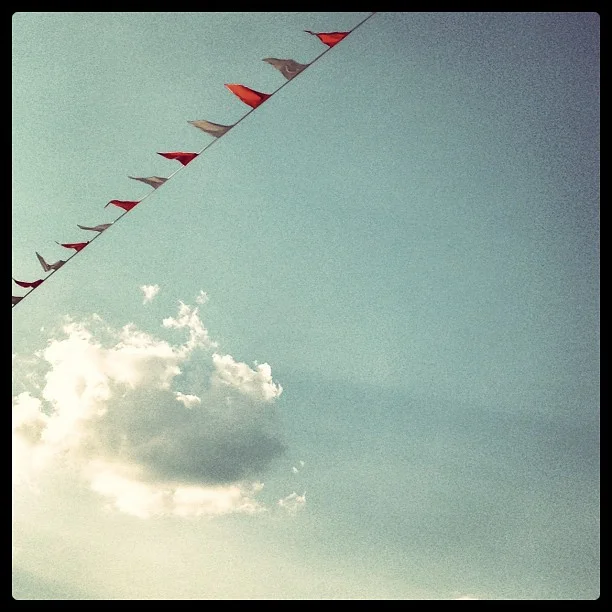I know, I know. The whole Forrest Gump quote thing is a little bit vintage and just a tad overused. But when it comes to how I paint, it's difficult to find a quote more apropos.
When you think of a painter painting, what do you picture? Do you think of someone standing in front of a canvas on an easel, palette and brush in hand, painting some nice trees or animals? Do you think of someone carefully controlling the colors just so, so that the atmospheric perspective and the composition are just so? Well...that's not how I paint at all.
A typical painting session for me looks about like this. I head over to Home Depot and pick out two or three colors of paint that I like. Depending on the size of the canvas I'm getting ready to paint, I'll buy a gallon and a couple of quarts of paint and head home to my studio (aka my garage). I'll tape a tarp or a drop cloth down, if I haven't already, unwrap the plastic from the canvas, and lay it on a jerry rigged 4 foot square wooden frame I cobbled together on top of the tarp. I get those paint cans open and without further ado start pouring it on to the canvas. When I've got enough poured (in varied colors and patterns that I like), I'll grab one edge of the canvas and start letting that paint go where it may. I'll tilt the canvas back and forth in various directions until its completely covered and "voila!", a new painting is born.
Now here's where the title quote, "Life is like a box of chocolates. You never know what you're gonna get.", is utterly relevant to my process. The way that the colors mix, the initial pattern that I choose, the thickness of the layers of paint, and the way that I move the canvas are all variables that shape how the final piece will look. And often times, even when I think I have a good final pattern, something as simple as a surface that's not perfectly level or how quickly the paint dries will completely change the end result.
Take the two images above, for example. Guess what? They're before and after shots of the same painting! The first is the one I intended, the second is what happened when I didn't lay it to dry on that level surface I referred to a moment ago. While the second has it's own beauty, it's amazing (especially to a non-detail oriented person like me) to me how much a detail like that can change everything. While that non level surface was responsible for the majority of the lost composition, you can see the effects of the different thicknesses of paint and their drying rates in the thin strips of white in the middle of the piece. In the second of the two images, they almost look broken away from the other two. Admittedly, this is also part of the nature of the way the white (or pigment-less) paint interacts with the other paint, but still, it's been incredibly fun to experiment to see how the paint will react when subjected to different techniques (like how it dries when it's layered at different thicknesses, what happens when I add blown air to the process, and even when I come at it with an open flame! [umm, yeah, no. Paint's a little too flammable for that]).
I hope you enjoyed this little peek into my process and my brain. Hopefully you'll stay with me on my journey to see what comes of all this...thinking....nope, still no open flames! :)
![Orange2[1].jpg](https://images.squarespace-cdn.com/content/v1/5227c75ce4b00447185b031f/1468860577751-HCRCIK5NX5HW6GXVLS17/Orange2%5B1%5D.jpg)
![01a8f02b9410c22ef25ade24973e8e15717a59255c[1].jpg](https://images.squarespace-cdn.com/content/v1/5227c75ce4b00447185b031f/1468860573457-1O58O454P14I2V1NT5Z2/01a8f02b9410c22ef25ade24973e8e15717a59255c%5B1%5D.jpg)
![01e12d141efe0cac52a1707b2ed88e9349ca0a2ce4[1].jpg](https://images.squarespace-cdn.com/content/v1/5227c75ce4b00447185b031f/1468860573635-DOVZL4W8SS6ECP0QW09V/01e12d141efe0cac52a1707b2ed88e9349ca0a2ce4%5B1%5D.jpg)
![01f5843216eb1a5e3eb77ae0a4163a975356aa5324[1].jpg](https://images.squarespace-cdn.com/content/v1/5227c75ce4b00447185b031f/1468860574289-F3787Z5NPFDEI8LSIIZK/01f5843216eb1a5e3eb77ae0a4163a975356aa5324%5B1%5D.jpg)
![010ba2685c9f3ec156b04ff0f40214aba88fa58c4b[1].jpg](https://images.squarespace-cdn.com/content/v1/5227c75ce4b00447185b031f/1468860574546-B22MK0CRWDHO6YHX9C02/010ba2685c9f3ec156b04ff0f40214aba88fa58c4b%5B1%5D.jpg)
![010e04fb105de97defafc85cea27ca0b0a0e4c2de1[1].jpg](https://images.squarespace-cdn.com/content/v1/5227c75ce4b00447185b031f/1468860575025-FANMIOLHTUPTX01OWAZH/010e04fb105de97defafc85cea27ca0b0a0e4c2de1%5B1%5D.jpg)
![015afc8723e604c4f6926ecf878cca25f650e81946[1].jpg](https://images.squarespace-cdn.com/content/v1/5227c75ce4b00447185b031f/1468860575319-3FY2HXPIX1MKVZ0F4CP8/015afc8723e604c4f6926ecf878cca25f650e81946%5B1%5D.jpg)
![018e3ecf5dedb5cbb458223c00cd5d00035d9746dd[1].jpg](https://images.squarespace-cdn.com/content/v1/5227c75ce4b00447185b031f/1468860575720-YVM240DW1M5QE8PIM6Y1/018e3ecf5dedb5cbb458223c00cd5d00035d9746dd%5B1%5D.jpg)
![0154d2aca5f14d04b83590a432954fb34593c3373b[1].jpg](https://images.squarespace-cdn.com/content/v1/5227c75ce4b00447185b031f/1468860576280-UGNYSRRPZ2J1DLWBMPOQ/0154d2aca5f14d04b83590a432954fb34593c3373b%5B1%5D.jpg)
![01995c3e684245b339a35bb0fbe7d100de9df9768a[1].jpg](https://images.squarespace-cdn.com/content/v1/5227c75ce4b00447185b031f/1468860576983-QEPT9TS69TLNJWEGNT8B/01995c3e684245b339a35bb0fbe7d100de9df9768a%5B1%5D.jpg)












